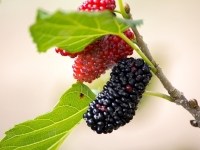MMMM . . . MULBERRIES!!!
Mulberries are like having really sweet blackberries high on a bush or tree where you can reach them! And the best part? No thorns!
There are 3 classes of mulberries: Morus nigra (black), Morus rubus (red), and Morus alba (white). And at least 5 varieties of mulberries commonly grown across Florida: 3 black varieties, plus red and white. Differences include size of the berry, whether they grow in sun or shade, and how much cold will they thrive in.
While mulberries can be either male or female, the varieties we carry are cutting propagated from fruit bearing trees, and as such will all produce fruit the first year. They are considered self-fertile.
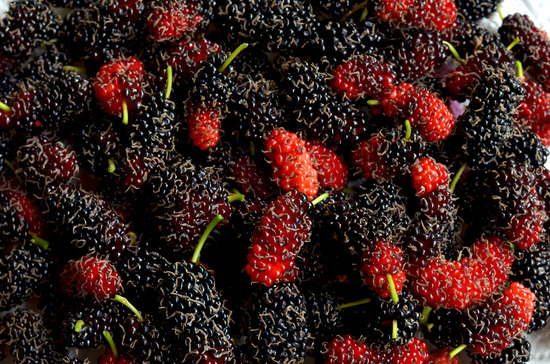
MMM . . . MULBERRIES
Common Black Mulberries
Morus nigra
Easiest of all the mulberries to grow in FL:
Common Black Mulberries are long lived trees and have been known to live and bear fruit for hundreds of years.
Native to southwestern Asia, the common black mulberry can grow as much as 30-35' tall as a single trunk tree or can be shaped into a 10' tall bush with multiple trunks. Plant away from driveways to avoid staining cars.
Sweet black fruits are said to be the best quality mulberries, and average 3/4" to 1" long .
Usually ripens in May and June.
Does well in full sun, tolerates some shade as well.
Zones 7-10: Can withstand cold freezes down to nearly 0°.

Trees are 3g / 4' to 6' tall, 2 yr old root stock;
Can be easily shaped into bushes if you prefer;
Mulberries ripen mostly in May or early June; black mulberries are the sweetest in this area (zone 9)
potted trees for local delivery only: no shipping;
order your mulberries below in 3g, 7g or 15g sizes

Everbearing mulberry on the right.
'Everbearing' Mulberries
Morus nigra
Everbearing may actually be a cross between our American Red and a White mulberry. Named such because it fruits in cycles from spring to fall.
Everbearing tends to be a smaller bush, and not as vigorous as the common black mulberry, with somewhat smaller berries as a rule --- average 5/8"-3/4" in length. It is cold hardy to zone 4, and can be grown as far north as Illinois. Many Everbearing are meant for just zones 4-8, though some are adapted well to Central FL. But be sure to buy ones that are grown in FL as all are simply labeled "Everbearing" with no further distinctions!
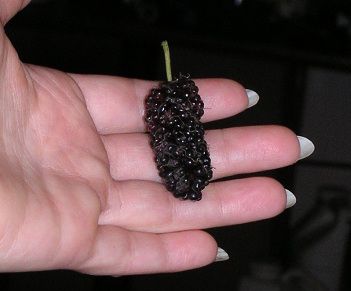
Peruvian mulberry
'Peruvian Giant' Mulberries
Morus nigra
Native to Peru as the name suggest, Peruvian Giant are noticeably larger than our Common Black mulberries. Fruits average 1.5-1.75" in length and are plump much like the Common Black. Flavor is quite similar. Ripens May & June.
Peruvian Giant likes full sun, and is cold tolerant to about 20-22°, or the lower half of zone 9a. Can be adapted to the upper half of zone 9a if planted in a wind protected area rather than out in the open field.
Has very large leaves and is best grown with a single trunk as a tree-shape, rather than a bush.
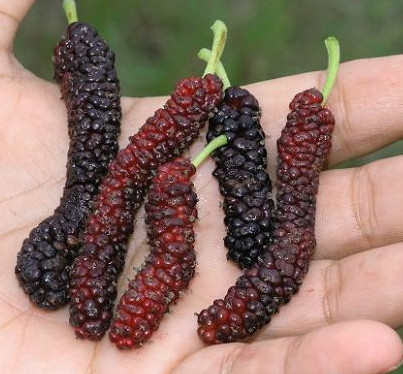
Pakistani mulberries are typically long and slender
'Pakistani' Mulberries
Morus nigra
Native to the Himalayan Mountains, 'Pakistani' is generally cold tolerant to 22-25° when young, and maybe zone 7 (0-10°) when fully mature -- maybe.
'Pakistani' (or sometimes referred to as 'Himalayan' mulberry), produces a sweet, rich flavored berry that varies from 2-5" in length, but averages about 2- 2.5" long in Florida. It may be that the lack of available trace minerals is the limiting factor.
Trees prefer full sun.
Cold hardy to zone 9b when young, maybe 7b or 8a when mature.
Has been known to produce several crops per year in zones 9b & 10a in coastal Texas.

young white mulberry fruits
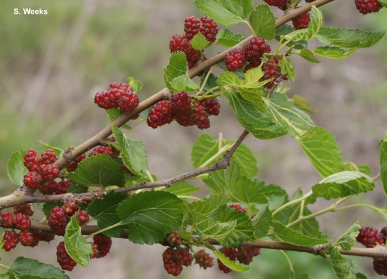
ripening white mulberry fruits (credits: Purdue Univ)
White Mulberries
Morus alba
White mulberries are vigorous growing trees, spread easily in full sun, and are hardy, dependable producers of many berries. They are the most tolerant of all the mulberries of poor soils.
Named for the color of its flowers, white mulberries are the most cold tolerant of the species. Most research shows they are large growing trees up to 80' tall, if unpruned, but Purdue Univ suggests they only get up to 40' tall. Maybe that is for Illinois.
Leaves on a white mulberry are fairly small, at a mere 3-4" in diameter. Shape will vary from the oval appearance of an elm-shape to the lobed appearance of a hand, somewhere between a tulip poplar or a fig shape.
Native to eastern and central China, white mulberries were introduced to America in the Colonial Era and have naturalized, sometimes crossing with the American Red, unbeknownst to the consumer.
White mulberries are very sweet and mild, but lack the tartness or the sweet-tart blend found in black mulberries. The berries are green while young, but will usually turn light red or even black when riping, rarely remaining white or lavender-white.
Needs full sun.
Cold hardy for zones 4-6, tolerating temps below freezing to -20 degrees, yet also hardy for zones 7-10 as well.
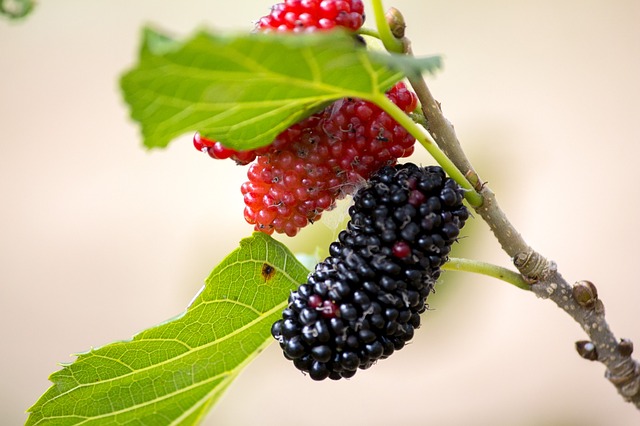
American Red mulberries
American Red Mulberries
Morus rubus
The Red or American mulberry is native to the Eastern US and is the only one of the species that actually prefers a shady environment. Trees are often found at the edges of the woods in its natural habitat.
Red mulberry can grow up to 60-70' tall if the soil is rich enough. They rarely live more than about 75 years.
Leaves of the red mulberry vary in size from 4-10" and are larger and darker green than the white mulberry leaves at 3-4". Leaves are larger if they have more shade.
The fruit is red when young and ripens to a rich, dark red or even black, while the flavor resembles that of a black mulberry --- very sweet, with very little tart overtones.
All varieties are limited in 15g.
References:
University of Wisconsin: http://uncommonfruit.cias.wisc.edu/mulberry/
Purdue University: https://www.extension.purdue.edu/extmedia/FNR/FNR_237.pdf (comparison of Red & White mulberries)
California Rare Fruit Growers: https://www.crfg.org/pubs/ff/mulberry.html


